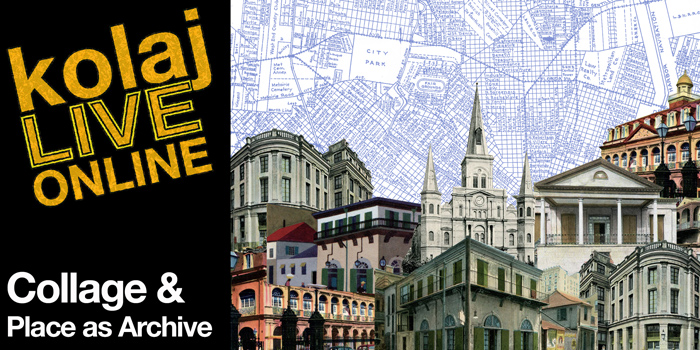
KOLAJ LIVE ONLINE
Artists in the Archives: Collage & Place as Archive
Wednesday, 11 January 2023 at 7PM EST (0000 UTC)
Presented in partnership with the Henry Sheldon Museum’s Stewart-Swift Research Center
GET TICKETS | PURCHASE THE BOOK
In Fall 2022 and Spring 2023, Kolaj Institute is presenting a series of Kolaj LIVE Online events in partnership with the Henry Sheldon Museum’s Stewart-Swift Research Center as part of the exhibition, “Artists in the Archives”. On the occasion of the 50th anniversary of the Stewart-Swift Research Center, the Henry Sheldon Museum of Vermont History invited an international network of collage artists to engage with historic material in the archive and to create a folio of collage prints that reflect on the idea of community in a 21st century world. Learn more about the project HERE.
Literary critic Michael Sheringham spoke about place as archive in a 2016 interview. “Many archives combine all sorts of matter; some of it vitally important and a lot of it just stuff, dross, repetitious bumph. But the other crucial ingredient is the idea of the archive as a process, something that takes place by virtue of the activities of compilation, preservation, juxtaposition, accumulation and so forth, that actually make archival space—at least potentially—active and dynamic. It’s the archive as a dynamic process that combines heterogeneous timescales, scrambles origins and mashes up elements from different horizons. That is what is exciting to us today…So, to think of a city as an archive is to think in terms of dynamic process, restless motion, multiple chronologies and levels of meaning.” Approaching place in this way is fertile terrain for collage artists who seek to incorporate a sense of place into their practice. During this Kolaj LIVE Online event, panelists will present artwork and discuss what it means to explore a place through the collage artist lens.
In November 2022, a group of collage artists met in New Orleans to explore the Collage Artist Lab: City as Archive took as its premise that the urban landscape can be viewed as a sort of archive with which artists can draw from, not unlike a material archive maintained by an institution.
“I was looking in the archives for the presence of Black New Orleanians in every day and grand moments of revelry and rebellion,” said Brooklyn-based artist S. Erin Batiste. “My selection reflects the in between, fleeting moments of Black beauty and boldness and swagger, of Black New Orleans unapologetically taking up space, both in the grand and everyday.”
Pictures of a boy eating sugarcane and a woman selling pralines in the New Orleans Public Library’s Postcard Collection led Brooklyn-based artist Aisha Shillingford to make collage that speculates on what New Orleans would be like if enslaved people were allowed to hold onto their culture. “The reason I wanted to do that is because one of our Lyft drivers was talking to us about not knowing where his ancestors were from, and his family had been here several generations. I wanted him to know that the archives could tell him that they were most likely either from Senegambia directly or by way of Haiti,” she explained. The collage bridges two stories. “One is the story of Jean Saint Malo who was the leader of a Maroon community on the outskirts of the city. [The collage] is imagining if his community wasn’t discovered and he wasn’t captured. How might it have flourished and what their life might have been like, might have continued to have been like? The thread that it’s connecting to is that someone like him would have been from Senegambia. It’s assuming that their Senegambian culture would have flourished and then noticing that the praline seller and the young boy both are kind of still echoing Senegambian attire.”
Artists from the Lab in New Orleans will be joined by artists who participated in the Collage Artist Residency in Scotland in Fall 2022. Using the rural community of Sanquhar, Scotland as a laboratory, artists spent a week making artwork; learning about the place, its people, and its history; and discussing how art can capture, share, reflect, comment, and otherwise engage with a sense of place. The goal of the residency was to develop an individual methodology for responding to place in one’s art practice and to make a work of art about Sanquhar that speaks to and about the people and land. During this Kolaj LIVE Online event, Denver-based artist Jennifer Evans will speak about how stories of witches turning into hares and her own exploration and photography of Sanquhar’s environs informed the artwork she made while in residency. Vancouver-based artist Aimee Henny Brown will speak about how her artwork, Metaphoric Rocks, came about.
The panel will be led by Ric Kasini Kadour whose own practice uses historical images to draw out a sense of place. At a talk in November 2022 on the subject, Kadour said, “When artists approach a place as an archive, they can draw out a deeper understanding of that place that enriches our understanding of our communities, helps us be better citizens, and empowers us to take better care of our neighbors.” Kadour will speak about how Artists in the Archives at the Henry Sheldon Museum is an example of collage artists engaged with place and Kolaj Institute’s 2023 initiatives that bring together artists to explore place and make art that uses history and folklore to speak to communities.
